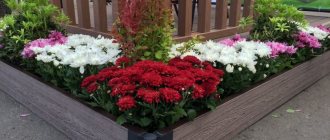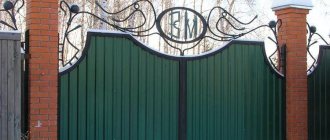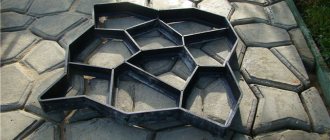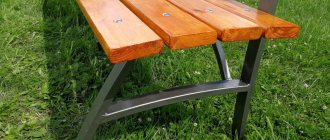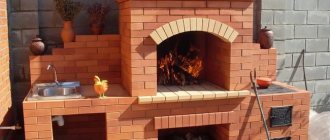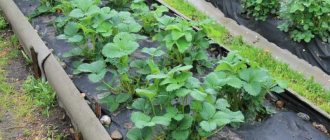Fences for beds - universal purpose
Looking at photos of garden bed fencing, you can see a variety of materials used to build walls around crops.
This is very expressive, but the real uniqueness of thematic designs lies in the following properties:
- Do not allow the soil to spread beyond a certain area after precipitation;
- They prevent the weeds that are outside from growing deeper into the beds, and also contribute to the rapid collection of weeds inside the crop zone;
- They make it easy to install arcs to cover the beds with greenhouse film;
- They protect perennial crops in winter and, thereby, relieve the gardener from spring cultivation;
- They retain heat in the soil if the latter protrudes above the level of the main soil and has a warm organic layer underneath.
If you make fences of different heights, they will fill the landscape with shape by default. And this is not to mention the rational zoning of the site.
On a note. For the winter, inside the sides, if nothing grows there, you can “settle” a bunch of leaves and other waste to create compost. Plants and seeds can be planted in such a base without any fertilizing.
Location of beds on a summer cottage: useful recommendations
If you are thinking about planting seeds or creating seedlings, you need to choose the right place and understand how to arrange the beds on the site. The quality of the harvest and the health of the vegetation will depend on this. Our grandmothers also argued that all seats should be located strictly in one position: from north to south.
It is convenient to approach the beds if they have paths around them filled with crushed stone PHOTO: yandex.com.tr
This method provides for a uniform supply of heat and light to future plants. In addition, in this arrangement the likelihood of fungus forming on leaves and fruits is minimized.
This design is only permissible if the site is perfectly flat and has no slopes. Such an area will not cause stagnation of moisture after precipitation, so the roots of the plants will not rot.
Two or three varieties of crops can be planted in one bed PHOTO: stopdacha.ru
The beds can be arranged in the form of various shapes (rectangles, triangles and polygons). However, proper organization of row spacing is important here. The ease of caring for plants depends on this.
Related article:
This article tells you how to make beds for the lazy . Photos and descriptions of the most successful ideas, as well as ways to implement them, should help make your site comfortable and well-groomed.
Fencing for garden beds - what types are there?
Gardeners and gardeners are captivated by the fact that borders for garden beds can be made from any building material and more.
The main thing is that there is enough of it. Then it will be possible to make many thematic boards of different heights, shapes and areas.
Regarding the choice of material, the target audience prefers:
- Wood;
- Vine;
- Plastic bottles;
- Slate;
- Decorative rock;
- Brick;
- Metal;
- Car tires.
The above diversity already awakens inspiration for creative exploits. But you need to choose consumables wisely. Therefore, let's look at the advantages and disadvantages of each of them.
Slate
Old slate can be used to decorate beds. For strength, it is recommended to first make a base. Wooden sheathing is suitable for these purposes. Sheets of slate are attached to it with roofing nails or special glue.
It is advisable to proceed with caution during installation, as this is a fairly fragile material. You can also make low beds from it by sticking small pieces of slate around the perimeter of the bed.
Wood sides
Of course, there is always enough wood. Even if there is no planting or forest nearby, there will always be worn out and broken wooden products.
Some of them are made of chipboard and MDF. But does it really matter when their profile is buried in the ground?
Decomposition, if it occurs, will occur within several years. As a result, the advantages of fencing for beds made of wood are obvious:
Ground cover roses: photos, best varieties, planting features, cultivation and recommendationsSolar garden lamps: overview of all types, operating principle, maintenance, design + selection instructions
- A DIY mailbox is a beautiful decoration and a useful addition to a suburban area
- Availability;
- Stability (strength);
- Suitability for mechanical and chemical processing;
- Air permeability (good for the root system);
- Compliance with the landscape.
Wooden walls also have a disadvantage - they are susceptible to rot and insects. Therefore, before fencing the beds with wood, it is recommended to soak the latter with an antiseptic.
On a note. Conifers contain resins, making them resistant to fungi and rot. Their property is very suitable for creating walls around crops.
Required materials and tools:
- plastic panels or lining
- glue<<Titan>>, <<Installation Moment>> or liquid nails
- carpenter's nails for window posts
- wooden blocks
- hammer
- hacksaw for metal
- construction cord or rope
Before starting construction, you need to draw up a clear plan. Use wooden blocks and cord to make markings. Check that the diagonals of each individual fence match.
Then cut the panels to the required length, glue them to the bars and secure with nails. The height can be from 15 to 50 cm. The width is 1-1.2 m. Wooden blocks are driven into the ground to a depth of 20-25 cm every 1.5 meters.
Sides made of plastic bottles
For the last few years, plastic fencing for garden beds has been in trend. While appropriate framing was gaining popularity, gardeners noticed a number of advantages:
- Availability of containers;
- The ability of plastic not to decompose in the soil;
- Multicolor when using colored bottles.
All that remains is to mark the territory, create a trench and begin deepening the containers. There are no downsides to such a barrier.
On a note. It is better to bury plastic bottles with their noses inside the soil so that flat caps protrude above its level, which are safe for contact after a possible fall.
Stone sides
If there are a lot of remains of bricks, cinder blocks and other concrete-clay building materials on the site, then they can become a good “Chinese wall” for crops.
It’s even better when the stone is decorative. From it you can already build patterns that are akin to ponds. However, for some, simple construction waste is enough. They allow:
- Create borders of any shape;
- Function as a side drainage system;
- Serve as intended for many years.
If only the gardener or gardener had the patience to alternate uneven stones. This will have to be done hundreds of times.
On a note. In order for the stone fence to have a solid appearance, the holes between its fragments can be filled with cement mortar.
Natural stone - this is how you can inexpensively fence a place where you can grow vegetables in your dacha
You can find plenty of stones anywhere: on a river, on hillsides, in gravel pits. There are many options for making permanent stone curbs. The simplest and most affordable way is to fill the space between two mesh metal gratings dug around the perimeter of the box. Such a fence is called a pergon. In such a stone “bag” zucchini and tomatoes, cucumbers and beets will feel comfortable. And other vegetable crops that are grown in beds will be comfortable inside a natural, environmentally friendly fence.
There are many options for making permanent stone curbs.
Brick sides
If there are no problems with brick volumes and all major construction projects are left behind, then clinker can be assigned a thematic task. His finished wall will be:
- Durable;
- Neat;
- Durable.
Before construction, you will also have to purchase cement and sand. This is the disadvantage of brick fencing for garden beds - it is expensive. In addition, you will have to take into account its considerable weight and piece-by-piece installation, which takes a lot of effort and time.
On a note. Standard clay brick is more wear-resistant than its white silicate counterpart.
When using red building material to fence plants, you must remember to lay bricks with through holes to ensure drainage to the soil.
Metal sides
Sheets made of low-alloy steel quickly rust in the ground, while galvanized fences are protected from the corresponding misfortune.
And if there is nothing else to use besides them, then it’s time to get down to business. True, there are several “BUTs”:
- Firstly, metal sheets heat up in the sun, which is why they must be placed at a distance from the green mass;
- Secondly, thematic material can weigh a lot, which will require reliable fastening using thick branches or twigs.
In general, galvanized sheets are not very suitable for the role of fencing for garden beds. They do not rust or bend, but instead of expensive metal it is beneficial to use something affordable.
Original options for high ridges
Having understood the principle of assembling a simple rectangular structure, it can be modernized in a way that suits you. It all depends on desire and imagination. Wood is such a “flexible” material that with its help, hardworking owners of their gardens and summer cottages create real masterpieces of design art.
Here are just a few examples with photographs:
Pyramid bed
Excellent for growing strawberries, spicy and medicinal herbs when there is a shortage of space, creating multi-tiered flower beds or an alpine slide
Fence bed
An ideal option for zoning the territory. Instead of a classic fence, you get additional places for planting or flower beds
Bed-wall
Allows you to increase the usable area of the site and decorate the blank walls of buildings
Compositions from non-standard shapes
Nobody forces boxes to be strictly rectangular or square - trapezoids, polygons, and circles have a place on the site
Beds-benches for a recreation area
If you want to relax on a comfortable bench, admire the flowers and enjoy the harvest at the same time, combine a classic bench with equally classic box beds
Another example of a bed-bench
Sides made from car tires
This material hardly corresponds to the word “sides” due to its size and shape. But how many advantages does it have when protecting the harvest is at stake:
- Original execution (especially after painting);
- Resistance to decomposition;
- Strength.
And, of course, the heavy weight of car tires makes deepening it difficult. Don't forget that it accumulates heat. Because of this, tires are more suitable for decorative purposes.
On a note. Instead of blocking the beds with tires, plants can be planted inside the tires themselves. This technique is especially relevant for flower beds and individual shrubs.
Required tools and materials
- Galvanized profile 10-50 cm wide.
- Edged board 22-25 mm thick.
- Wooden beam
- Roofing screws 40-45 mm long.
- Hammer
- Wood hacksaw
- Metal scissors or grinder
- Screwdriver
The technology for assembling such a fence is similar to that described above. Only instead of glue, self-tapping screws are used. Additionally, you can attach a greenhouse to it, no more than one meter high. All wooden elements must be treated with an antiseptic.
In conclusion
You can improve your garden plot with different items, be it a panel for fencing beds or car tires for a flower bed.
The main thing is that themed products are found all the time, which only makes “garden repairs” cheaper.
